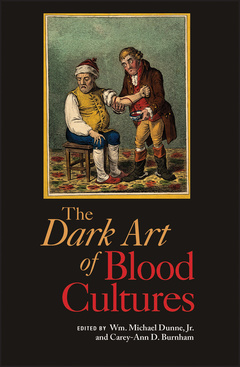Dark Art of Blood Cultures ASM Books Series
Coordonnateurs : Dunne Wm. Michael, Burnham Carey-Ann D.

In the clinical microbiology laboratory, blood is a critical diagnostic sample that, in the majority of cases is sterile (or is it?). However, when microbes gain access to and multiply in the bloodstream, it can result in life-threatening illness including sepsis. Mortality rates from bloodstream infection and sepsis range from 25% to 80%, killing millions of people annually. Blood cultures are a vital technology used in the microbiology laboratory to isolate and identify microbes and predict their response to antimicrobial therapy.
The Dark Art of Blood Cultures, edited by Wm. Michael Dunne, Jr., and Carey-Ann D. Burnham, surveys the entire field of blood culture technology, providing valuable information about every phase of the process, from drawing samples to culture methods to processing positive cultures. The Dark Art of Blood Cultures is organized around several major topics.
- History of blood culture methods. Details the timeline of blood culture methods from manual through automated and describes the technological development of the leading automated blood culture systems (Bactec, BacT/Alert, and VersaTREK).
- Manual and automated blood culture methods. Critiques manual and automated methods for setting up blood cultures for adult and pediatric patients.
- Detection of pathogens directly from blood specimens. Describes currently available CE marked and FDA-cleared commercial tests using both phenotypic and genotypic markers, including their strengths and limitations.
- The workflow of culturing blood. Includes best practices from specimen collection to culture system verification, processing positive cultures for microbe identification and antibiotic susceptibility determination, along with the epidemiology of positive blood cultures and the value of postmortem blood cultures.
- Microorganisms in the blood. Examines the concept of a blood microbiome in healthy and diseased individuals.
The Dark Art of Blood Cultures is a resource that clinicians, laboratorians, lab directors, and hospital administrators will find engaging and extremely useful.
If you are looking for online access to the latest clinical microbiology content, please visit www.wiley.com/learn/clinmicronow.
Contributors
Foreword
Preface
Acknowledgments
About the Editors
I Perspectives on the Art and Science of Blood Culture
1 Historical Perspectives on the Art and Science of Blood Culture
William Michael Dunne, Jr.
2 Conventional Blood Culture Methods
Robyn Atkinson-Dunn and William Michael Dunne, Jr.
3 Lysis-Centrifugation Methods of Blood Culture
Erin McElvania TeKippe and Morgan A. Pence
4 BACTEC Blood Culture Systems
Robin R. Chamberland
II Modern Methods in Blood Culture
5 The BioMérieux BacT/ALERT: Automation at Last in the Black Box
Bradley Ford and George Kallstrom
6 TREK Blood Culture Systems
Neil W. Anderson and Melanie Yarbrough
7 Molecular Methods for Detection of Pathogens Directly from Blood Specimens
Mark D. Gonzalez and Robert C. Jerris
8 Pediatric Blood Cultures
Paula Revell and Christopher Doern
9 Epidemiology of Bloodstream Infections
Allison R. McMullen, Craig B. Wilen, and Carey-Ann D. Burnham
10 Best Practices in Blood Cultures
Robert J. Tibbetts and Barbara Robinson-Dunn
11 Processing Positive Cultures
Matthew L. Faron and Nathan A. Ledeboer
12 Fungal and Mycobacterial Blood Cultures
Robert S. Liao and William Lainhart
IV New Developments in Blood Culture
13 The Bacterial Blood Microbiota/Microbiome
Eileen M. Burd and Lars F. Westblade
Index
The Dark Art of Blood Cultures is a resource that clinicians, laboratorians, lab directors, and hospital administrators will find engaging and extremely useful.
Wm. Michael Dunne, Jr., PhD, is currently a senior research fellow for bioMérieux, Inc. in Durham, North Carolina. Priorto joining bioMérieux, he was Medical Director of the Diagnostic Microbiology Laboratory at Barnes-Jewish Hospital and Professor of Pathology and Immunology, Molecular Microbiology, Pediatrics, and Medicine at Washington University School of Medicine in St. Louis from 2000-2011 and remainson the faculty there. During that time, he established an internationally-recognized training program in medical and public health microbiology, which is still active under the direction of Carey-Ann Burnham. He has previously served as Medical Director of Microbiology Laboratories at Henry Ford Hospital (Detroit, Michigan), Texas Children's Hospital (Baylor College of Medicine, Houston, Texas) and Children'sHospital of Wisconsin (Medical College of Wisconsin, Milwaukee, Wisconsin, where he had received his PhD in 1982). Dr. Dunne is a Diplomate of the American Board of Medical Microbiology and a Fellow of the American Academy of Microbiology, the Infectious Diseases Society of America, the Pediatric Infectious Diseases Society, and the Canadian College of Microbiology. He served as a senioreditor of the Journal of Clinical Microbiology for ten years and remains on the editorial board. He is also an Adjunct Professor of Pediatrics at Duke University School of Medicine, Durham, North Carolina. He has authored or coauthored over 170 peer-reviewed publications and 10 chapters, in addition to this book.
Carey-Ann D. Burnham, PhD, completed her PhD in Medical Sciences at the University of Alberta in Edmonton, Alberta, Canada and her postdoctoral training in Medical and Public Health Microbiology at Washington University under the direction of Wm. Michael Dunne, Jr. Currently, Burnhamis an Associate Professor of Pathology & Immunology, Molecular Microbiology, and Pediatrics at Washington University in St. Louis School of Medicine. Burnham
Date de parution : 09-2017
Ouvrage de 320 p.
15.2x22.6 cm
